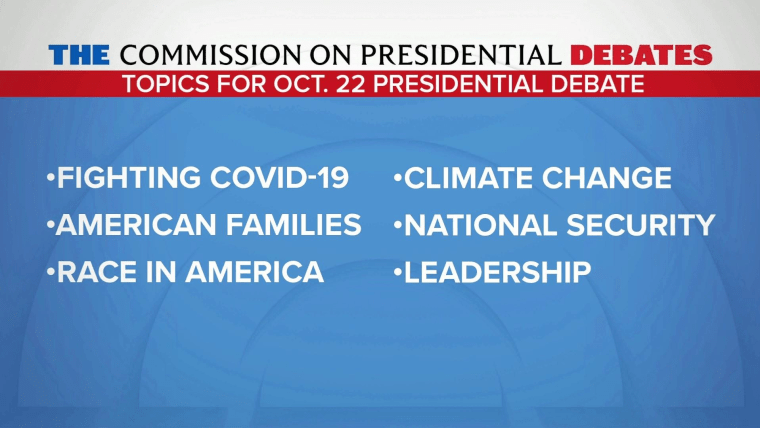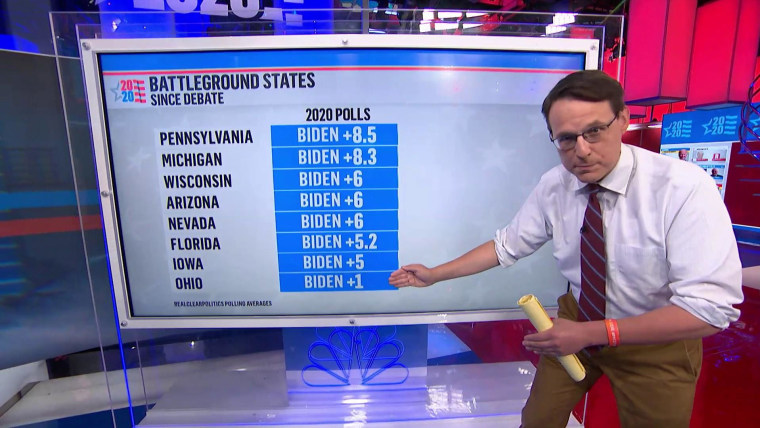WASHINGTON — It’s Republicans’ biggest hope and Democrats’ biggest fear: That the 2020 election will be a rerun of 2016, with an upset victory for Donald Trump despite polls and conventional wisdom showing Joe Biden is on his way to the White House.
Four years ago this month, Trump’s campaign was essentially left for dead as Hillary Clinton expanded her lead, Republicans fled the apparently sinking ship and Lin-Manuel Miranda taunted Trump with a rendition of “Never going to be president now” to the delight of Saturday Night Live fans.
But, of course, Trump ended up winning and his campaign says he can do it again.
“Looking back at the election of 2016, most members of the media had the polling wrong, and that’s really important to understand where we are today,” former Trump campaign manager Corey Lewandowski told reporters, predicting a Trump blow out.
Some parallels between then and now are almost eerie.
The “Access Hollywood” tape and Trump’s Covid-19 news both came on Fridays 32 days out from the election. Biden and Hillary Clinton had the same 11-point lead in the October NBC News/Wall Street Journal poll. And there’s even a late-breaking email controversy involving a laptop of unexpected origins, just like the one that revived Clinton’s email scandal days before the election.
So what’s the same and what’s different from 2016?
1. The message
In 2016, Trump was an outsider. Now he’s the president with a record to answer for and facing voters who are generally unhappy with the state of the country.
In the home stretch four years ago, he surprised some observers by largely staying off Twitter and staying on message as he drove home his argument that “Crooked Hillary” was everything wrong with the Washington establishment. That kept the spotlight on Clinton and helped drive late-deciding voters Trump’s way.
This year, Trump’s campaign is pushing a similar message against Biden — but Trump himself is often distracted.
The president sometimes seems more interested in relitigating his race against Clinton than pursuing his current opponent. He hasn’t articulated a clear second-term message. And he seems to be running as much against the news media as he against Biden. After Thursday’s town hall on NBC, Trump’s campaign declared that he “soundly defeated NBC’s Savannah Guthrie.”
“For most of the general election (in 2016), he was very disciplined and on message. You knew very clearly what his campaign was about and what he would do as president. Whether you agreed or not, you knew,” said Republican strategist Matt Gorman. “That is not the same this time.”
2. The opponent
Biden is more popular, less divisive and more difficult to caricature than Clinton, whom Republicans had spent decades attacking going back to her time as the first lady in the 1990s.
“The loathing of the Clintons was just ingrained in a lot of these voters,” said Republican strategist Tim Miller. “Some of it was sexism. Some of it was my fault. Some of it was her fault. She was under investigation by the FBI during the election.”
Miller was one of Clinton’s biggest antagonists in the run-up to 2016 when he worked for a GOP opposition research super PAC. Now, he’s the political director of Republican Voters Against Trump, which supports Biden.
Four years ago, polls showed voters viewed Trump as more honest and trustworthy Clinton, so his attacks on her resonated in a way they have not against Biden, who is now seen as far more trustworthy than Trump.
And Biden’s white working-class roots make him “culturally inconvenient” for Trump, as former Obama strategist David Axelrod has put it, making him appealing or at least tolerable to a wider range of Americans.
But like Clinton four years ago, Biden has maintained a moderate campaign schedule in the closing weeks as Trump flies from swing state to swing state, packing in multiple events a day.
“I think you’re going to see the president just flat out out-work Joe Biden in the home stretch just like he did against Hillary Clinton,” said Jason Miller, another Trump 2016 veteran who is back to advise the current campaign.
3. The map
The 2020 election is being fought in more states than the 2016 race, when Democrats took for granted the so-called “Blue Wall” states that they didn’t even realize were battlegrounds, like Wisconsin, which Clinton failed to visit before losing it.
Biden and allied Democratic groups are now flush with cash and competing for both 2016 swing states and new ones, like Arizona and Texas.
Trump threaded the needle on his path to victory four years ago by winning Wisconsin, Michigan and Pennsylvania by fewer than 80,000 votes, combined. This year, the president could repeat that path to 270 Electoral College votes, but he has very little room for error.
Still, Trump won last time by turning out unexpected voters and there are still millions of white working-class non-voters who could come off the bench to cast a ballot for Trump. The last election also showed even the most informed observers can be paying attention to the wrong states and it’s possible Trump’s efforts to expand the map into places like Minnesota and New Hampshire could bear fruit.
“I wake up in the morning and I try to figure out what to go worry about. I have a ‘Vote Biden’ hat on right now, but it really should say PTSD,” said Bradley Beychok, the president and co-founder of the Democratic super PAC American Bridge. “But in 2020, Democrats are going to run through the tape to defeat Trump so my 2016 redux fears diminish by the day.”
4. The polling
Biden’s lead is more stable than Clinton’s ever was. There are fewer undecided voters, fewer voters opting for third-party candidates and fewer who say they are open to changing their minds before Nov. 3. Indeed, millions have already voted. And most experts see no evidence of “shy Trump voters” who hide their preference from pollsters, exaggerating Biden’s real lead.
All that makes it difficult to imagine where Trump could find the kind of unexpected surge that helped put him over the top in 2016.
Voters who disliked both candidates in 2016 broke heavily for Trump, but they appear to be breaking for Biden this time, as are people who voted for third-party candidates or didn’t vote in 2016.
Pollsters, meanwhile, have learned a lot in four years, when they came close to predicting the national popular vote but missed the results in key states. And they’re conducting more polls, especially on the state level, giving a better picture of the race.
Still, pollsters had some notable misses in the 2018 midterm elections, when they once again overestimated the strength of some Democratic candidates. And turnout, always difficult to predict, is an especially thorny question during the coronavirus pandemic.
W. Joseph Campbell, a professor at American University and author of the recent book, “Lost in a Gallup: Polling Failure in U.S. Presidential Elections,” said history shows pollsters often get elections wrong — but they rarely do so for the same reason twice, so there could be some new unforeseen issue that pollsters overlooked as they fought the last war.
“It’s not going to be a duplication of what we saw in 2016,” he said. “Elections are all different.”
5. The electorate
The 2018 midterm elections demonstrated the power of the suburban revolt against Trump, which has helped move states like Arizona toward Biden. And there’s some evidence that older voters, a pillar of Trump’s 2016 coalition, are softening on the president, too.
Meanwhile, Democrats are unlikely to have the same the problem they did in 2016 when many of their core voters, including tens of thousands of African-Americans in critical swing states, stayed home because they didn’t take the threat of Trump seriously.
“People are just organizing on a continual basis now,” said Democratic strategist Lynda Tran. “I’m not sure I’ve seen a presidential cycle where people are more motivated than they are now.”
But some parts of the electorate have moved in Trump’s direction.
The president appears to have made inroads with Latinos, for instance, and peeling away even a few percentage points could matter in tight races.
Republicans also have swamped Democrats in adding new voters to the rolls, which is a very different story from 2016, since Democrats typically focus more on voter registration but pared that effort back during the Covid-19 pandemic.
6. The parties
The two major political parties each are more unified than they were four years ago, when Trump faced GOP calls to drop out after the Access Hollywood tape surfaced and Clinton struggled to attract Bernie Sanders’ progressive voters, some of whom cast ballots for Green Party nominee Jill Stein.
If all of Stein’s votes in Wisconsin went to Clinton, she would have won the state. Libertarian candidate Gary Johnson won 4.4 million votes, including many from disaffected Republicans.
This year, far fewer voters say they plan to vote for a third-party candidate. The current Green and Libertarian Party nominees are far less visible or aggressive than Stein or Johnson were and say they expect many of their would-be supporters to vote for Biden to stop Trump.
But the pandemic has given Republicans two new potential advantages.
First, they’ve continued to organize door-to-door while Democrats have mostly sat out the ground game and instead organized digitally — a big reversal from 2016 when Clinton had far more boots on the ground than Trump. Second, Democrats are counting on their voters to figure out how to request and return ballots via the mail, which adds a new wrinkle to their get-out-the-vote operations.
“Ballots don’t return themselves,” Trump campaign manager Bill Stepien told reporters. “We have the best ground game…in political history. Joe Biden has none.”













